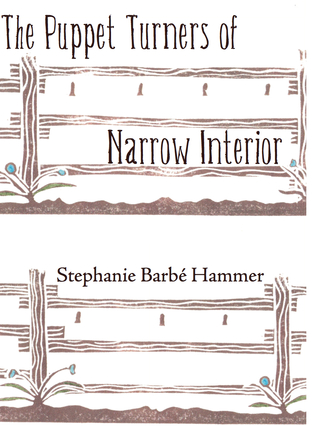Just down the road from John Crowley’s characters is the town of Narrow Interior, the setting for Stephanie Hammer’s fable-ous first novel of secrets and heritage. Henry, the youngest son of a hotel magnate, is sent to calm the inhabitants as the hoteliers set about to despoil this odd byway. Instead, aided by his black sheep cousin and a cast of quirky characters, including Quirk, Henry sets out to discover the town secrets. The more he learns, the darker his mission appears, until Henry must choose if he is willing to risk all.
Goodreads description
The Puppet Turners of Narrow Interior has much in common with Magic America (see my last review). It starts with magic realism as the world seen through the eyes of a child; it features a fight against American big business whose plans are endangering a community; it even has a magic realist tattoo! But in many ways it is very different. In contrast to Magic America the frequency of magic increases through the course of the book, so much so that the book moves away from magic realism towards fantasy à la Neil Gaiman.
The book can be categorized in many ways - there is a strong streak of humour and satire here, which had me chuckling at times; there are a lot of references to classic philosophers and writers (including Schiller and Goethe as talking condiment pots), legends (Parsifal and the Fisher King anyone?) and then there's surrealism (I was reminded of Leonora Carrington's writing at times). In fact there is so much going on and Stephanie Hammer is having so much fun in writing the story that sometimes I felt the book failed to deliver completely on its promise(s). But then how could it?
I personally was interested in the puppets strand, which disappointed as did the religious backstory to the community of Narrow Interior. The two elements are related and so much more could have been done with them. Puppet theatre has always had a relationship with religion and not just
in Japan: marionette means little Maria and the shadow puppets of South
Asian portray tales from the Mahabharata and Ramayana. I worked for several years as the manager of the Puppet Centre of Great Britain and in that capacity saw the power and magic of puppets, nowhere more evident than in the ancient Japanese art of Bunraku, which the novel draws from, but doesn't explore.
The book could have been simply a book of ideas, but the characterization is strong and amusing. We engage with Henry from the get-go and even as he decides to hide his character (So,
I become secret. I study unspecialness and silence. While most people
in American work to develop ersatz talents, individualistic quirks, and
even the occasional eccentricity, I let mediocrity shine like a beacon
of nothingness. A black hole of personality.) we empathize and yearn for the real Henry to reappear. But again I felt that the author engaged our interests in certain characters (most notably Quirk and the old man Olsen) only to let them drop.
So, in conclusion, what did I make of this book? I enjoyed it, it is a fun and interesting read, but I don't think it is magic realism.
I received this book from the publisher in return for a fair review.

No comments:
Post a Comment